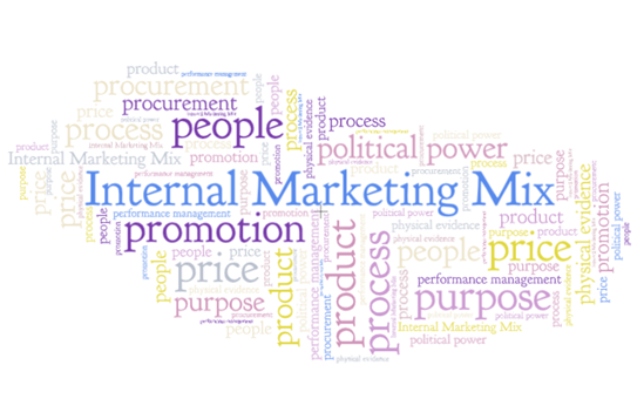
Understanding the 10Ps of internal marketing to empower employees for better business results
Internal marketing is all about using a marketing-like approach to respond to and satisfy employees’ needs in a similar way to how an organisation deals with its external customers. The idea is to make employees feel cared for and valued by the organisation so that they develop positive behaviours and attitudes towards their work (especially in the form of employee satisfaction, organisational commitment and employee engagement). These attitudes and behaviours of customer-contact employees in particular influence the customer’s perception of service quality during the service encounter and, ultimately, the level of customer satisfaction experienced, which directly impacts business results.
Internal marketing comprises marketing methods geared towards the attraction, development, retention and inter-functional coordination of employees, with the overall objective of enhancing employee satisfaction, while creating service quality and satisfaction for the customer. The 10 internal marketing mix elements that I have investigated and developed as part of my model are:
- internal product
- internal price
- internal promotion
- internal people
- internal process
- internal physical evidence
- internal political power
- internal performance management
- internal procurement
- internal purpose
How internal marketing fits into the organisation
Since it is the employees who create the customer’s perceptions of service quality and satisfaction, it is important that employees have exposure to the internal marketing mix and that organisations understand the connection between internal marketing and service quality and customer satisfaction, to the extent that these relationships can be leveraged in a positive way.
Modern organisations serve two types of markets, the internal market made up of the organisation’s employees and the external market made up of the organisation’s customers. Success in today’s world is a function of the organisation’s ability to effectively manage the interrelationships that exist between these two markets and effectively align internal market objectives with external market objectives.
In order to create value for both internal and external customers, a strong focus on internal marketing mix is required, as each of the elements has the potential to influence employee behaviour and satisfaction. Let’s unpack each one in a little more depth.
1. Internal product Internal product essentially refers to the employee’s job. Training and development, role fit and career advancement are the key components that make up the concept of internal product. The underlying view of internal marketing is based on the idea that in order for an organisation to have satisfied customers, it must first have satisfied employees. If employees relate positively to their jobs through the internal product elements and are provided with the capability to perform their jobs well, they are: a. likely to experience higher levels of satisfaction, b. enabled to produce service quality, and c. better equipped to satisfy the needs and wants of external customers.
2. Internal price Internal price refers to the value employees gain from working for the organisation, in the form of the monetary benefits paid in return for their time and knowledge, less the costs of working for the organisation. These monetary benefits include salary, bonuses and other benefits. Costs incurred, include the opportunity and psychological costs employees take on to work for organisations. When employees feel that the costs or sacrifices they make to work for the organisation are too high, they may experience high levels of stress and withdraw either physically or psychologically. This results in adverse effects during service encounters such as rudeness, unresponsiveness to customer requests, and in some cases, aggressive behaviour towards customers.
Rewards should be linked to service quality objectives, and KPIs should be clear and specific metrics should be in place. Reward must be clearly aligned to performance. Current internal marketing theory suggests that if employees are not provided with effective rewards and elements to reduce their stress and psychological costs, they become incapable of performing their jobs and serving customers well, which results in the delivery of poor service quality and high levels of customer dissatisfaction.
3. Internal promotion
This element in the internal marketing mix refers to how organisations communicate with employees to create a greater understanding of the vision in order to persuade them to achieve the organisational objectives. When employees are not aligned with the vision and objectives, this creates deep feelings of disconnectivity.
Internal advertising, face-to-face communication, promotions and social media are considered to be vital components of an internal communication or promotional strategy. Well-informed employees who understand the organisation’s vision, external marketing strategy and brand, as well as how this relates to their jobs, are more satisfied and become the organisation’s best brand ambassadors. This, in turn, allows employees to deliver on the brand promise and to enhance service quality and customer satisfaction, thereby enhancing the organisation’s reputation and brand image.
4. Internal people
From an internal marketing mix perspective, the ‘internal people’ concept includes the relationship with supervisors/direct managers and with co-workers. The quality of the supervisor/management-employee relationship as well as support and encouragement from colleagues promotes a harmonious working environment in which employee satisfaction can be fostered. In addition to this, when employees are guided and supported by management and colleagues, they are enabled to serve customers well, which results in enhanced service quality and employees who feel motivated to go above and beyond the norm to satisfy customers.
5. Internal process
The process aspect of the internal marketing mix refers to how the internal customer receives the internal product, which includes work processes. If the employee knows what to do and how to do it, this promotes competency and improved employee satisfaction and motivation. Process and operating procedures increase the levels of employee comfort, which allows employees to serve customers better. Further to this, internal processes that are streamlined and effective lead to better service delivery, and organisations that succeed in the delivery of service quality and faster turnaround times, will have more satisfied customers.
6. Internal physical evidence
Internal physical evidence (which incorporates internal place) refers to the work environment, including décor, layout, equipment and technology, and the channels within the environment such as meeting rooms and offices in which the internal product (job) is delivered. The layout of office space and the appearance of the internal environment have an impact on employee satisfaction, motivation and employee performance – factors which enable employees to provide a better service to customers. In addition to this, organisations rely heavily on physical evidence to create perceptions of service quality and satisfaction for customers.
7. Internal performance management
A performance measurement system is an important tool in the management of organisations to ensure that strategies such as customer satisfaction are implemented for organisational success and performance. Alignment between employees’ roles and key performance indicators (KPIs) is paramount. The broader organisational objectives and departmental objectives must be clearly communicated to employees, and employees should have clarity on how their roles relate to these. If performance management processes were to be improved so that employees have clearly defined KPIs and receive regular performance feedback, this could have a greater bearing on internal satisfaction levels. This could then improve both internal and external service quality resulting in external customer satisfaction.
8. Internal purpose
When employees share a common purpose and find meaning in the work they do, they are, in turn, motivated to create value for customers. Deloitte’s Global Human Capital Trends Survey (2014) shows that “any workplace that lags in inspiring passion and purpose will suffer by losing key employees, and at an increasing rate as the global economy picks up momentum”. Internal marketing theory concerning the internal purpose elements suggests that clarity of purpose for employees becomes an important driver of employee satisfaction which, in turn, drives service quality and customer satisfaction. Thus, many organisations are focusing on driving purpose, rather than profits.
9. Internal political power
Political power refers to a form of nepotism in which certain employees benefit from preferential treatment, instead of going through the official channels. It can certainly be argued that if political power can be managed in a more successful manner by being better controlled and reduced, this would have a more positive impact on the internal environment and result in greater employee satisfaction and engagement. Through the control of political power, the right people would be promoted into the right positions based on merit and skill, enabling employees to serve customers better and resulting in improved service quality and higher levels of customer satisfaction.
10. Internal procurement
Internal procurement is closely related to internal service quality in the notion that the organisation must serve those who serve. Internal procurement typically focuses on the procurement of people, referring to the recruitment and selection process, followed by the organisation’s endeavours to ensure that customer-orientated people with the right attitudes and skills are recruited into the right jobs in order to serve their internal customers well.
Recruitment and selection tactics are key competencies required for internal marketing success, as these enable organisational performance through the procurement of customer-minded employees. Recruitment is recognised as an essential internal marketing mix element. If the wrong employees are placed in the wrong roles, they will neither be able to establish strong relationships, nor serve their internal or external customers adequately. This would have negative consequences for service quality and customer satisfaction objectives. Hence, the quality of services provided internally influences an employee’s ability at the customer interface to serve customers well. This, in turn, affects the quality of service provided externally, thus influencing the customer’s feelings of satisfaction.
Different Ps hold different power
Having outlined the 10Ps, it’s clear how they work together to affect the ability of employees to deliver service quality and customer satisfaction. But it is important to understand which of these elements holds the most power in influencing employee and customer satisfaction in your organisation, so that focus may be given to them during the structuring of an internal marketing programme, and which elements require further development.
So get in touch if you need help determining which Ps hold what power in your organisation and how you can leverage them to get the best business results.
